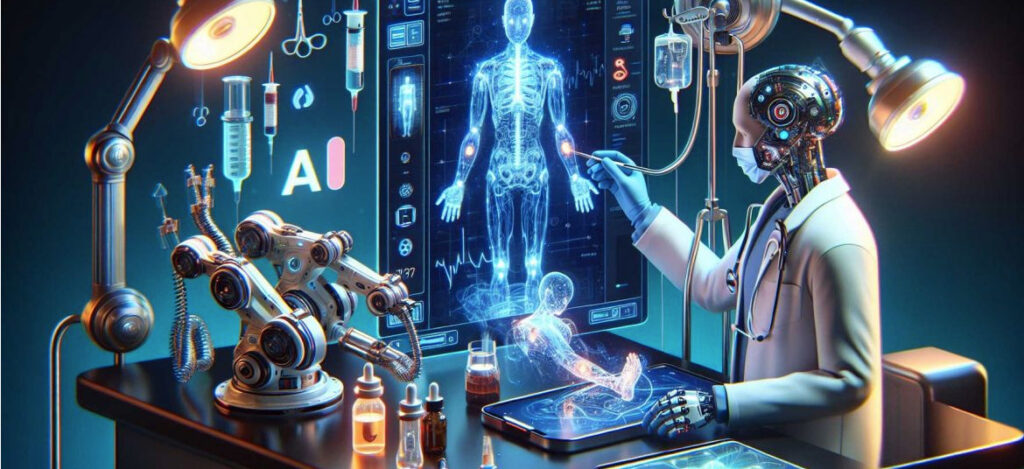
TRANSFORMING MEDICAL DEVICE IN MEDICAL DEVICE AI BUILT IN
Transforming a simple medical device into an AI-powered medical device using Google Cloud (or other platforms) is an exciting and impactful project. By integrating AI, you can enhance the device’s capabilities, such as predictive analytics, real-time monitoring, and decision support. Below is a step-by-step guide to help you achieve this transformation:
1. DEFINE THE USE CASE AND REQUIREMENTS
· Identify the Problem: What specific medical problem are you trying to solve? (e.g., early diagnosis, patient monitoring, anomaly detection).
· Define the AI Functionality: What AI capabilities do you want to add? Examples include:
o Image analysis (e.g., X-ray, MRI, or ultrasound interpretation).
o Signal processing (e.g., ECG, EEG, or blood pressure analysis).
o Predictive analytics (e.g., patient deterioration prediction).
o Natural language processing (e.g., extracting insights from medical records).
· Regulatory Considerations: Ensure compliance with medical device regulations (e.g., FDA, CE marking, GDPR for data privacy).
2. CHOOSE THE RIGHT AI PLATFORM
Google Cloud offers a suite of tools for building AI-powered medical devices. Here are some key services:
GOOGLE CLOUD AI/ML SERVICES
· Vertex AI: A unified platform for building, training, and deploying machine learning models.
· AutoML: For training custom models with minimal coding.
· Healthcare API: For managing and analyzing healthcare data (e.g., FHIR, DICOM).
· BigQuery: For large-scale data analytics.
· Cloud IoT Core: For connecting and managing IoT-enabled medical devices.
· Edge AI: For deploying AI models directly on the device using TensorFlow Lite or Coral Edge TPU.
OTHER PLATFORMS
· AWS IoT Core + SageMaker: For IoT and AI integration.
· Microsoft Azure IoT Hub + Azure Machine Learning: For similar use cases.
· Open-Source Frameworks: TensorFlow, PyTorch, or ONNX for custom AI development.
3. DATA COLLECTION AND PREPARATION
· Collect High-Quality Data: Gather labeled datasets relevant to your use case (e.g., medical images, sensor data, patient records).
· Data Annotation: Annotate data for supervised learning (e.g., labeling tumors in X-rays).
· Data Preprocessing: Clean, normalize, and preprocess data for AI model training.
· Data Privacy: Ensure compliance with HIPAA, GDPR, or other regulations. Use anonymization techniques if needed.
4. DEVELOP AND TRAIN THE AI MODEL
· Model Selection: Choose the right AI model architecture (e.g., CNN for images, RNN/LSTM for time-series data).
· Training: Use Vertex AI or AutoML to train your model on Google Cloud.
· Validation: Validate the model using a separate dataset to ensure accuracy and reliability.
· Explainability: Use tools like Explainable AI (XAI) to make the model’s decisions interpretable for healthcare professionals.
5. INTEGRATE AI WITH THE MEDICAL DEVICE
· Cloud Integration: Connect the device to Google Cloud using APIs or IoT Core for real-time data processing.
· Edge AI: If real-time processing is required, deploy the AI model directly on the device using TensorFlow Lite or Coral Edge TPU.
· User Interface: Develop a user-friendly interface for healthcare professionals to interact with the AI-powered device.
6. TESTING AND VALIDATION
· Clinical Validation: Test the device in a clinical setting to ensure accuracy, safety, and efficacy.
· Performance Testing: Evaluate the device’s performance under various conditions.
· Regulatory Testing: Conduct testing required for regulatory approval (e.g., FDA 510(k) clearance).
7. DEPLOYMENT AND MONITORING
· Deploy the Device: Roll out the AI-powered device to healthcare facilities.
· Monitor Performance: Continuously monitor the device’s performance and update the AI model as needed.
· Feedback Loop: Collect feedback from users to improve the device over time.
8. COMPLIANCE AND CERTIFICATION
· Regulatory Approval: Work with regulatory bodies to obtain necessary approvals (e.g., FDA, CE marking).
· Quality Management System (QMS): Implement a QMS to ensure compliance with ISO 13485.
· Cybersecurity: Ensure the device meets cybersecurity standards (e.g., IEC 62304).
Example Use Case: AI-Powered ECG Monitor
1. Use Case: Detect arrhythmias in real-time using an ECG monitor.
2. AI Functionality: Train a deep learning model to classify ECG signals.
3. Data: Collect labeled ECG data from patients with and without arrhythmias.
4. Model: Use TensorFlow or PyTorch to build a CNN model for signal classification.
5. Integration: Deploy the model on the ECG monitor using TensorFlow Lite for edge inference.
6. Testing: Validate the device in a clinical trial.
7. Deployment: Launch the device and monitor its performance in real-world settings.
TOOLS AND RESOURCES
· Google Cloud Healthcare API: https://cloud.google.com/healthcare-api
· TensorFlow Lite: https://www.tensorflow.org/lite
· Coral Edge TPU: https://coral.ai/
· FDA AI/ML-Based Software as a Medical Device (SaMD) Guidance: https://www.fda.gov/
By following these steps, you can successfully transform a simple medical device into an AI-powered medical device using Google Cloud or other platforms. Let me know if you need further assistance with any specific step!
